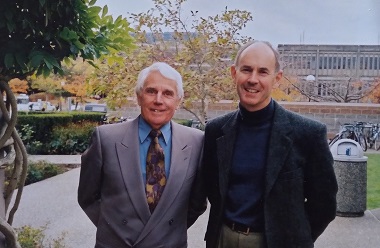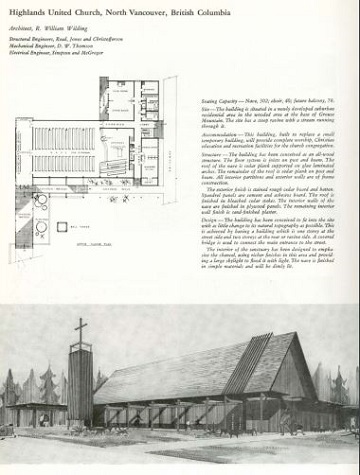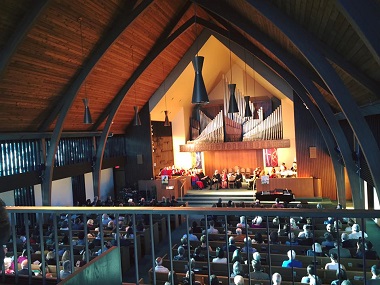
Trinity Baptist Church, at 49th and Granville.
Now in his 90s, Will Wilding is keeping a low profile during this Covid season, but he is able to look back on a unique journey – from his missionary childhood in the Belgian Congo to an accomplished career as an architect in Vancouver.
I had intended to cover both those elements of his life in one article, but each season deserves separate attention. See the accompanying article about his book Kabumbulu Congo.
Key church architect
Evidence of Wilding’s work can be found all over Metro Vancouver, and the province, especially in the form of churches and other religious buildings.
David Dawes wrote a good assessment of Wilding’s work for BC Christian News in 2002:
The man credited with revitalizing church architecture in the Greater Vancouver area is being honoured in an exhibit of photos by Simon Scott at Regent College’s Lookout Gallery.
‘Will Wilding: The Early Churches’ displays striking images of 19 churches built from 1954 to 1965; in all, Wilding has designed more than 180 churches.
“In the ’50s and ’60s,” says Lookout director Dal Schindell, “Wilding changed the face of what churches looked like – at least Protestant churches. He seems to have set the tone for that era. It was a Modernist equivalent of the way the Gothic style pulls you up – that’s Will’s look.”

Will Wilding, left, with Rhodri Windsor-Liscombe.
According to Rhodri Windsor-Liscombe, author of The New Spirit: Modern Architecture in Vancouver 1938 – 1963, Wilding was a significant figure of the Modernist movement in architecture.
I think his work was very adept at taking the ideas of Modernist architecture to create a new language of sacred form in the post-Holocaust era. The level of destruction of World War II – from the Holocaust to nuclear warfare – shattered many aspects of conventional faith.
Will Wilding was one of those people, in the post-war era, who was trying to re-understand the sacred – through very direct architectural means, such as the use of windows and support structures.
Wilding, says Windsor-Liscombe, endeavoured “to rethink what the purpose of design was, to rethink the making and meaning of space.”
 The results, he added, demonstrated “a high level of craft, and a genuinely spiritual dimension. There was an openness in his buildings – and a solemnity which allowed for ritual and liturgy, without being stuffy.”
The results, he added, demonstrated “a high level of craft, and a genuinely spiritual dimension. There was an openness in his buildings – and a solemnity which allowed for ritual and liturgy, without being stuffy.”
Wilding’s greatest influence was architect Charles Rennie Mackintosh (1868 – 1928) who, Wilding says, “had a great sense of decorativeness. His approach had a lot to do with trying to apply human scale to any given architectural situation.” Mackintosh “always liked lots of natural light. He was also very concerned with the final decor.”
When Wilding began working with Greater Vancouver churches, “many had fixed ideas, and wanted to stick with their heritage.” On the other hand, he says, “There were those that said ‘go for it’ – and in those instances I was able to use my creative abilities, with the influences of Mackintosh. In most cases, the response showed a willingness to move away from the staid, historical type of church.”
 His purpose, he says, was “to look anew at the atmosphere of a church – at forms, colours, materials, stained glass windows. I wasn’t wanting to produce a glorified Safeway. I wanted people to know it was a house of worship.”
His purpose, he says, was “to look anew at the atmosphere of a church – at forms, colours, materials, stained glass windows. I wasn’t wanting to produce a glorified Safeway. I wanted people to know it was a house of worship.”
The period documented by the exhibit, Wilding adds, was an exciting time. “There was a sense that ‘this is a new day’ – and it was related to what was happening in the evangelical church.”
Most of all, he concludes, “I was interested in the sacredness of what was going on in the churches, and I wanted to enhance the sacredness.”
The December, 1956 issue of the Journal of the Royal Architectural Society of Canada featured an article on ‘Design Factors in Building the Contemporary Church,’ which included a page devoted to Wilding’s Highlands United Church in North Vancouver.

Kerrisdale Presbyterian Church on west 41st Avenue, during a VST Convocation in 2016, from its Facebook page.
These are the churches and religious buildings featured in the Lookout Gallery (now Dal Schindell Gallery) exhibit:
- Highland United (North Vancouver)
- Trinity Baptist (Vancouver)
- Wilson Heights United (Vancouver)
- Lutheran Campus Centre (UBC)
- Bamfield United (Vancouver Island)
- Central Heights MB (Abbotsford)
- First Baptist (Kelowna)
- North Lonsdale United (North Vancouver)
- TWU Chapel (Langley)
- First Lutheran (Vancouver)
- Christian Reformed (Burnaby)
- St. Andrew’s United (Mission)
- Queen’s Avenue United (New Westminster)
- St. Andrew’s Presbyterian (Kamloops)
- Kerrisdale Presbyterian (Vancouver)
- Marineview Chapel (Vancouver)
- Calvary Temple (Kamloops)
- Mt. Olive Lutheran (White Rock)
- Tenth Avenue Alliance (Vancouver)
Among his many other churches are: Richmond Baptist; Cascades Gospel Chapel (Vancouver); Granville Chapel (Vancouver); First Christian Reformed (Vancouver); North Delta Evangelical Free; Johnston Heights Evangelical Free (Surrey); Good Shepherd Lutheran (Coquitlam); Gordon Presbyterian (Burnaby); St. Andrew’s United (Port Moody), Westminster Gospel Chapel (New Westminster), Gilmore Park United Church (Richmond).

Interesting how little we know of the adults in our life. I grew up with the Wildings as friends and neighbours, their kids being just a bit older than me. Stayed at their house in Dunbar on several occasions when my parents were traveling. Had no idea that Mr. Wilding (we would never have called an adult by their first name) was so accomplished and had done so much. Not sure I even knew that he had designed Marineview Chapel, where we attended church. Thanks for the article.
It was interesting, Flyn, that you linked Will to his father, Robert, and his Brethren missionary activity in some African countries. As a lad, at different times, I heard both Robert and Will Wilding preach at Oaklands Gospel Hall in Victoria, where my siblings, parents and I attended. (My maternal grandfather was a founding elder.) So, he was known as a both an architect and a fine lay preacher. I was a young teen and I recall talking to Will after a service where he preached.
He showed me a photo of four men, including himself, hiking in the Swiss Alps. They were all Youth for Christ workers at the time, on a recreational break. One of the others was a fellow named Billy Graham.
At that time, I recall Will’s preaching to be a bit like Billy’s – with a bit of a Scottish burr added. Later, when Oaklands Gospel Hall outgrew its 1913-built assembly hall, they built Oaklands Chapel, up the street. Will was the architect.
I often think fondly of Will, as he was my lay preacher who kindly nourished my first spiritual awakening as a young teen. He and his friend walked the streets of our neighbourhood, inviting us teens to his Friday night Teens Club at Southlands school and then to his brand new church close by, Marineview Chapel. Many fond memories are from there, where he was the minister, and at teens camp on Anvil Island. Once, Will jumped in his speedboat to rescue me and another camper from an overturned canoe. At home in Vancouver, I sometimes babysat his four children in his lovely home of which he was the architect.
And now I’m so grateful for knowing him and honoured to have been a part of his life for those short couple of years. What an amazing man!
Thanks for the article.
Re: Granville Chapel
Will Wilding was the architect for the addition of the second floor office/classrooms and the ground floor nursery in 1959.
The original church building was designed by ROBERT McKEE in 1949. McKee established what was then described as a pretty shocking Modernist church vocabulary, which Will added to sensitively a decade later.
(I have a historical article on that and also archival drawings if they might be of interest.)
On the topic of local church architecture, there were a few gems by Thompson Berwick Pratt and Partners, including specifically, Dick Mann.
Thank you, Will, for your input in the church community through beautiful architecture.
Thanks for this great story, Flyn. I know many of these buildings well, but never had connected Will Wilding as the common feature.
My strongest memory of Will Wilding was back when he spoke at our Sonlite Coffee House during the Jesus Movement on “Jesus the Man of Action” from the Gospel of Mark. Will emphasized the term “immediately” that Mark frequently used. Will has definitely been a man of action.
At the point, Will was active at Marineview Chapel, which had a booming outreach to UBC students in those days with many services. The late Len Sawatsky, an early Regent Student and youth pastor at Trinity Baptist, was friends with Will who helped Len out after he was let go from Trinity Baptist. The days of the Jesus Movement were very vibrant and intense. Thank God for Will Wilding.
Another wonderful sacred space Will Willing designed was Brentwood Presbyterian Church at 1600 Delta Ave in North Burnaby. It’s a small space, seating 100, but the acoustics, our musicking neighbours tell us, are just about perfect.
Though our primary missional connections are with the jazz communities in Greater Vancouver, we’ve hosted choirs, small classical ensembles, touring groups from across Canada, and recording sessions of all kinds. The musicians and the producers all rave about the sound and its transcendent qualities.
Thanks for this article, Flyn, and thanks most deeply to Will for the gift of this space. We pray we will continue to steward it faithfully, wisely and effectively as ambassadors of the Trinity’s forgiving and reconciling grace.